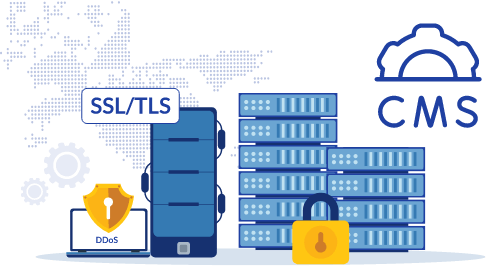Creating a Website
Today, creating a website is essential. Whether you’re an entrepreneur, craftsman, creator, or part of a company, your web presence builds visibility, credibility, and helps convert visitors. It involves key steps like reserving a domain name, server optimization, and the technical process.

3 Steps to Create a Website From A to Z
The process is split into three phases, adaptable to your skill level and resources.
Choose the Right Solution For Your Project
You can use a CMS like WordPress or Joomla for modular content management. Advanced users may code directly with front-end frameworks (React, Vue.js) or back-end engines (PHP, Node.js). Drag-and-drop editors offer a no-code, quick solution, perfect for simple sites.
Customize Design and Content
Customize your site with responsive templates. AI tools can generate page sections, visuals, and structured HTML. Edit directly in your account or via FTP.
Go Live Via An All-In-One Infrastructure
Once ready, publish your site by deploying it on a configured server. At PlanetHoster, hosting handles domain names, SSL certificates, databases, and monitoring without vendor lock-in.
Do Not Neglect the Domain Name and Hosting Solution
The Domain Name Impacts Your Brand Image
Pick a domain that suits your brand and SEO. Choose an extension matching your audience (.fr for French speakers, .com for international). Avoid long names or special characters, and align it with your business name. PlanetHoster offers over 1,500 extensions!

Choose a Hosting Solution Tailored to Your Technical Needs
Hosting impacts speed, scalability, and reliability. PlanetHoster offers:
- Shared hosting (World Lite, The World, The World Pro): ideal for showcase sites and blogs. Up to 100 GB disk, 8 CPUs, and 16 GB RAM.
- Dedicated server (HybridCloud): managed cloud plus dedicated power with Apache and Litespeed, 4–32 CPUs, and 8–256 GB RAM.
- VPS server: isolated resources for CPU, RAM, and storage, up to 32 CPUs and 256 GB RAM.
If you lack expertise, 24/7 managed support handles updates, backups, and tech assistance.

Customize the Site to Reflect Your Identity
Your website must represent your company’s visual identity clearly. Graphic customization is key for smooth user experience and brand consistency.
PlanetHoster lets developers code freely, while non-technical users use an intuitive drag-and-drop SiteBuilder with professional, responsive templates for desktop, tablet, and mobile devices.
Advanced users can access HTML/CSS/JS source code to modify styles, DOM elements, or add third-party libraries.
You can manage typography, colors, favicons, SVG icons, and vector logos directly within the interface.
Unlike some closed platforms, PlanetHoster doesn’t restrict source file or tool access—you retain full ownership of your site, code, content, and design.
What Features Does a Modern Site Need?
Focus on dynamic functions to meet goals like lead generation, online sales, communication, and marketing automation.

Secure Contact Forms
Forms must validate fields client-side (JavaScript) and server-side (PHP, Node.js) to prevent spam and injections. PlanetHoster enables Google reCAPTCHA and includes SSL/TLS by default.

Scalable E-Commerce Modules
E-commerce sites can integrate WooCommerce, Prestashop, or Magento with product, inventory, payment (Stripe, CB, PayPal), and delivery/tax management.

Marketing Connectors
Include landing pages, newsletters with secure SMTP, booking systems via APIs or plugins, plus Google Ads, Tag Manager, CRM, SEO tools (RankMath, Yoast), and DNS/SPF email setup.
Safety, Compliance and Technical Performance
Website reliability depends on three pillars: data security, legal compliance, and strong infrastructure.

Secure Trade and Resource Protection
SSL/TLS certificates (like Let's Encrypt) encrypt all client-server communication, ensuring secure HTTPS access.
Servers have active DDoS protection to handle attacks without service disruption. Automatic backups are performed with easy restoration.
Popular CMS such as WordPress and Joomla support automatic updates to reduce vulnerability risks.

Good Infrastructure and Fast Storage
The World and HybridCloud plans use SSD/NVMe servers for fast access, high I/O, and low latency. The infrastructure spans Tier III+ data centers in Montreal, Paris, and Lausanne.
Each site benefits from smart load balancing, 24/7 monitoring, and Anycast routing for optimal performance.
How Much Does it Cost to Create a Website?
Costs include domain, hosting, design, and maintenance. PlanetHoster offers simple all-in-one packages with no hidden fees.
A .fr domain costs less than 10 euros. World Lite shared hosting is free. World costs 6 euros/month; The World Pro is 8 euros/month. Plans include RAM, CPU, unlimited sites, email accounts, automatic CMS install, and SSL.
HybridCloud offers managed dedicated cloud servers with NVMe disks, data centers in France, Canada, and Switzerland, and proactive monitoring for high-demand sites.
- Shared hosting websites cost between 150 and 300 euros including design and maintenance.
- Dedicated server projects can cost between 700 and 900 euros.
Using SiteBuilder Pro, website creation is accessible for novices and pros alike, with intuitive management, customizable design, responsive layout, and budget control.
Whether a blog, showcase, or store, PlanetHoster ensures smooth UX, solid performance, SEO-friendly sites, and full ownership without vendor lock-in.
